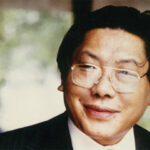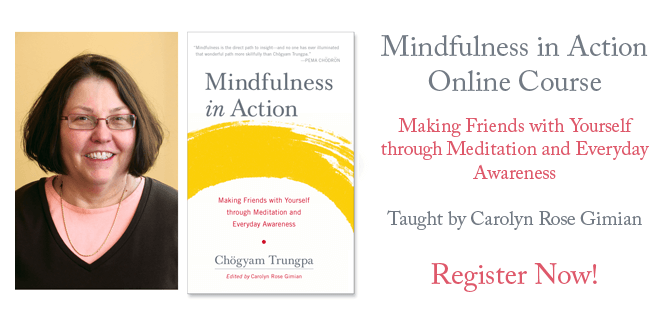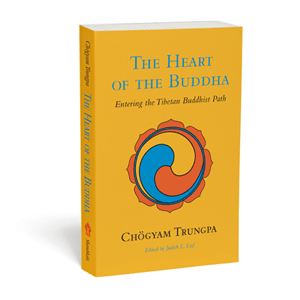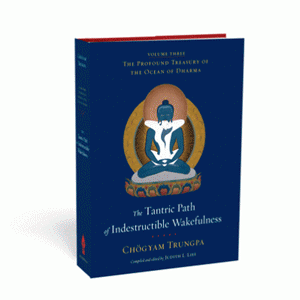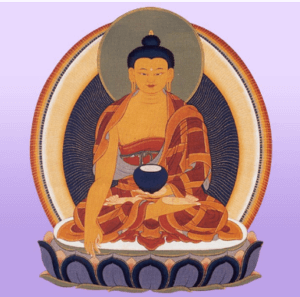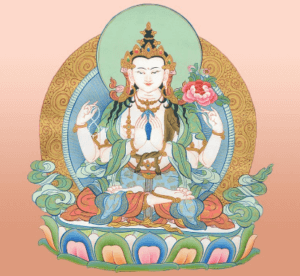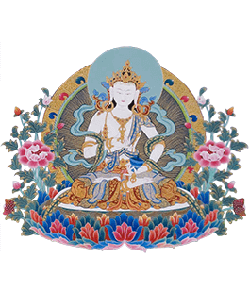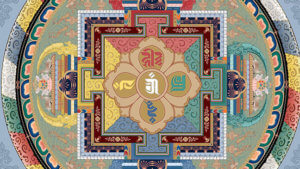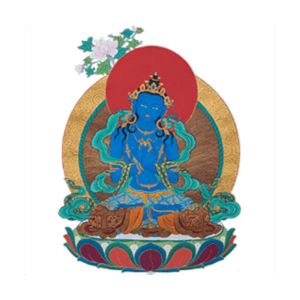Chögyam Trungpa Rinpoche’s impact on the transmission of Buddhism to the West cannot be overstated. In the quarter century he spent in the West, he taught tens of thousands of students, in many cases introducing them to Buddhism for the first time. His legacy is nearly impossible to measure, but one gauge is his literary output. Shambhala has published about three dozen unique books by, about, and based on talks given by Chögyam Trungpa, with that number growing still as some of his personal editors, in particular Carolyn Rose Gimian and Judy Lief, continue to take the original audio and transcripts of his teachings and edit them for publication as books. Amazingly, some of his earliest teachings are still those that resonate most strongly and seem the most fresh and up-to-date.
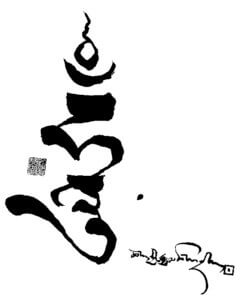

How to Navigate This Reader’s Guide
It can be daunting deciding where to start with his corpus of work—not just because of the prolificacy of titles, but because they span so many subjects. Of course, Rinpoche predominantly taught on the three vehicles of Buddhism with a fresh, modern presentation. But beginning in 1976, he also presented a secular set of teachings known as the Shambhala teachings (more about this below). He also taught extensively on art, poetry, psychology, death and dying, and many more topics, both within the scope of Buddhism but also in the context of the Shambhala teachings. [Note: The shared name between Shambhala Publications and these teachings is a curiosity of history—Shambhala Publications actually had the name before Trungpa Rinpoche had even come to the West. ”Shambhala” is an ancient name referring to a mythical kingdom in Asia whose inhabitants enjoy an enlightened society.]
Here you will find a guide to his works, loosely categorized and with recommendations on where to start.
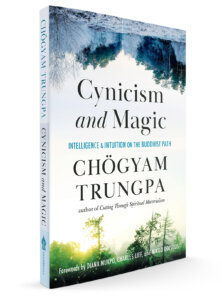
Cynicism and Magic: Intelligence and Intuition on the Buddhist Path
Based on a series of talks given by Chögyam Trungpa during the first session of what was to become Naropa University, Cynicism and Magic introduces key Tibetan Buddhist concepts, including karma, the structure of ego, the paramitas, and the bodhisattva. Employing a unique and intimate teaching style, Trungpa Rinpoche presents these concepts in a larger framework of questions we all have: What is authentic spirituality? Can I find enlightenment and freedom? How should I approach life, death, suffering, and boredom? How can I develop some discipline, patience, and sanity? Through these accessible teachings, this book will show you how to approach a living dharma with intelligence, and with a sense of openness and wonder.
Audiobook
Read by Devendra Banhart
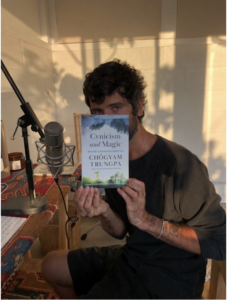
Entryways into Chögyam Trungpa’s voice, philosophy, and teachings
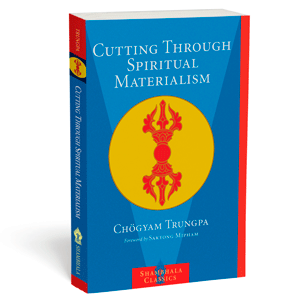
We will start with one book that in many ways defies categorization and is considered by many Buddhists and non-Buddhists alike as a spiritual classic. In Cutting Through Spiritual Materialism, Trungpa Rinpoche highlights the most common pitfall to which almost every aspirant on the spiritual path falls prey: what he calls spiritual materialism. The universal tendency, he shows, is to see spirituality as a process of self-improvement—the impulse to develop and refine the ego when the ego is, by nature, essentially empty. “The problem is that ego can convert anything to its own use,” he said, “even spirituality.” His incisive, compassionate teachings serve to wake us up from this trick we all play on ourselves, and to offer us a far brighter reality: the true and joyous liberation that inevitably involves letting go of the self rather than working to improve it. It is a message that has resonated with students for nearly thirty years and remains fresh as ever today.
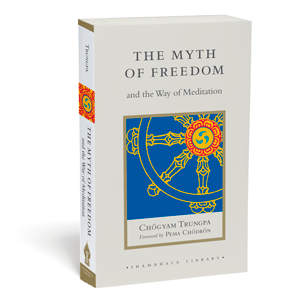
The Myth of Freedom and the Way of Meditation: Chögyam Trungpa’s unique ability to express the essence of Buddhist teachings in the language and imagery of modern American culture makes his books among the most accessible works of Buddhist philosophy. Here Trungpa Rinpoche explores the true meaning of freedom, showing us how our preconceptions, attitudes, and even our spiritual practices can become chains that bind us to repetitive patterns of frustration and despair.
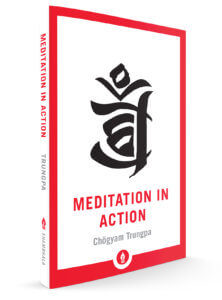
Not only was Meditation in Action the first book Trungpa Rinpoche wrote, it was also the first book Shambhala Publications ever published. In this work, he shows that meditation extends beyond the formal practice of sitting to build the foundation for compassion, awareness, and creativity in all aspects of life. He explores the six activities associated with meditation in action—generosity, discipline, patience, energy, clarity, and wisdom—revealing that through simple, direct experience, one can attain real wisdom: the ability to see clearly into situations and deal with them skillfully, without the self-consciousness connected with ego.
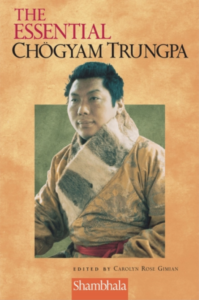
The Essential Chögyam Trungpa is an excellent starting point for those who wish to have a taste of the breadth of his work. It weaves excerpts from best sellers such as Shambhala: The Sacred Path of the Warrior, Cutting Through Spiritual Materialism, Meditation in Action, and other titles into a concise overview of his teachings. Forty selections from fourteen different books articulate the secular path of the Shambhala warrior as well as the Buddhist path of meditation and awakening. This “new classic” vividly demonstrates Trungpa Rinpoche’s great appreciation of Western culture that, combined with his deep understanding of the Tibetan tradition, makes these teachings uniquely accessible to contemporary readers. It will appeal to beginning students of meditation as well as those interested in Eastern religion.
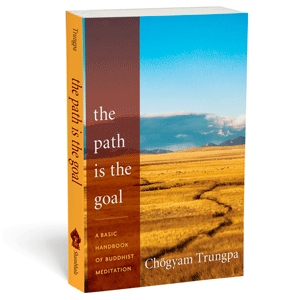
The Path is the Goal. The Buddha taught meditation as the essential spiritual practice. Nothing else is more important. These classic teachings on the outlook and technique of meditation provide the foundation that every practitioner needs to awaken as the Buddha did. Chögyam Trungpa here reveals how the deliberate practice of mindfulness develops into awareness, insight, and openness. He also guides us away from the ego’s trap: the urge to make meditation serve our ambition.
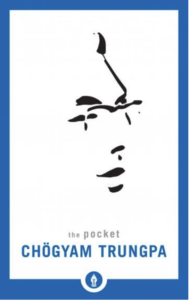
The Pocket Chögyam Trungpa. Trungpa Rinpooche used to say that wisdom can be taught only in the form of a hint—a hint that inclines us to recognize the wisdom in us all along. Here are 108 marvelous hints from the renowned teacher so supremely skilled at dropping them. This small book will serve as a compact introduction to his teachings for those not yet familiar with him—and as a wonderful source of daily inspiration for those who are.
Chogyam Trungpa was one of the first teachers in the West to use the terms mindfulness and awareness to talk about the practice of meditation and the states of mind that are associated with meditation. He was a pioneer in this area and many regard him as one of the fathers of the mindfulness movement. Today, mindfulness is being used as a helpful technique in education, health, working with pain, business, and many other fields. Chogyam Trungpa’s teachings are still fresh and relevant to the understanding of the power of mindfulness in working with the challenges of everyday life.
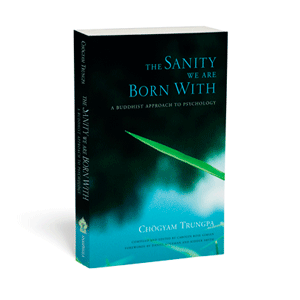
The Sanity We Are Born With: A Buddhist Approach to Psychology describes how anyone can strengthen their mental health, and it also addresses the specific problems and needs of people in profound psychological distress. Additionally, Rinpoche speaks to the concerns of psychotherapists and other health care professionals who work with their patients’ states of mind. The collection includes teachings on:
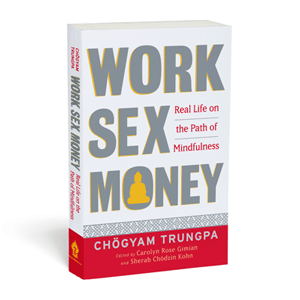
Work, Sex, Money: Real Life on the Path of Mindfulness. We all hope that these aspects of our life will be a source of fulfillment and pleasure, and they often are. Yet they are also always sources of problems for which we seek practical advice and solutions. The best prescription, according to Chögyam Trungpa, is a dose of reality and also a dose of respect for ourselves and our world. His profound teachings on work, sex, and money celebrate the sacredness of life and our ability to cope with its twists and turns with dignity, humor, and even joy.He begins by breaking down the barrier between the spiritual and the mundane, showing that work, sex, and money are just as much a part of our spiritual life as they are a part of our everyday existence. He then discusses these subjects in relation to ego and self-image, karma, mindfulness, and meditation. “Work” includes general principles of mindfulness and awareness in how we conduct everyday life as well as discussion of ethics in business and the workplace. “Sex” is about relationships and communication as a whole. “Money” looks at how we view the economics of livelihood and money as “green energy” that affects our lives. The result is an inclusive vision of life, one that encompasses the biggest issues and the smallest details of every day.

Mindfulness in Action: Making Friends with Yourself through Meditation and Everyday Awareness. The rewards of mindfulness practice are well proven: reduced stress, improved concentration, and an overall sense of well-being. But those benefits are just the beginning; it can also help us work more effectively with life’s challenges, expanding our appreciation and potential for creative engagement. This book provides all the basics to get you started, but also goes deeper to address the questions that naturally arise as your practice matures and further insight arises. A distillation of teachings on the subject by one of the great meditation masters of our time, this book serves as an introduction to the practice as well as a guide to the ongoing mindful journey.
Mindfulness in Action: Making Friends with Yourself through Meditation and Everyday Awareness We are so pleased to also offer an online course on this material, available on-demand, presented by one of Trungpa Rinpoche’s main students and editors, Carolyn Rose Gimian.
Heart of the Buddha: Entering the Tibetan Buddhist Path
In The Heart of the Buddha, Chögyam Trungpa presents the basic teachings of Buddhism as they relate to everyday life. The book is divided into three parts. In “Personal Journey,” he discusses the open, inquisitive, and good-humored qualities of the “heart of the Buddha,” an “enlightened gene” that everyone possesses. In “Stages on the Path,” he presents the three vehicles—Hinayana, Mahayana, and Vajrayana—that carry the Buddhist practitioner toward enlightenment. And in “Working with Others,” he describes the direct application of Buddhist teachings to topics as varied as relationships, drinking, children, and money. The Heart of the Buddha reflects Trungpa Rinpoche’s great appreciation for Western culture and deep understanding of the Tibetan Buddhist tradition, which enabled him to teach Westerners in an effective, contemporary way.
For the full overview of the three yanas (or vehicles of Buddhism), it would be difficult to dive deeper than the three-volume Profound Treasury of the Ocean of Dharma. In many ways Trungpa Rinpoche’s magnum opus, this set forms the complete overview of the Buddhist path. Edited by Judy Lief from many talks and seminar, this represents the most comprehensive presentation of the Buddhist path generally and the three yanas specifically.
As Judy Lief summarized, "the Hinayana refers to individual development and the path of the arhat ('worthy one'); the Mahayana refers to the joining of wisdom and compassionate action and the path of the bodhisattva ('awake being'); and the Vajrayana refers to fearless engagement and spiritual daring and the path of the siddha ('holder of spiritual power'). The three-yana approach presents a map of the path based on a student’s natural, developmental progression.
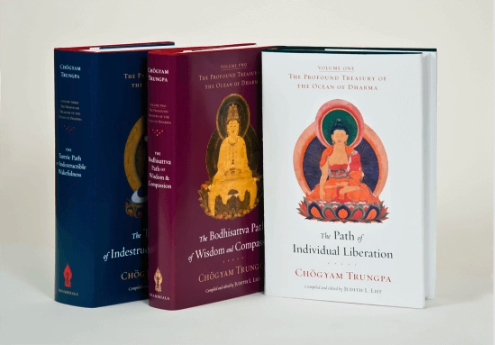
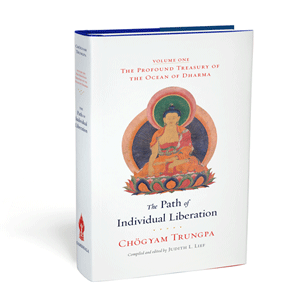
The first volume of the Profound Treasury of the Ocean of Dharma is The Path of Individual Liberation and is an excellent place to start. It covers in great detail topics such as the Four Noble Truths, karma, the four foundations of mindfulness, meditation, the refuge vows, the three jewels, the five skandhas, and more.
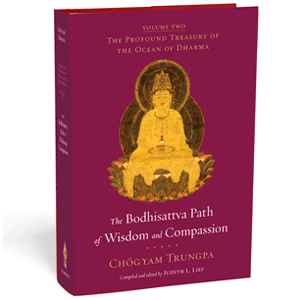
The second volume of The Profound Treasury of the Ocean of Dharma is called The Bodhisattva Path of Wisdom and Compassion. This is a complete overview of the Mahayana path and covers topics such as buddha nature, emptiness and compassion, the activity of a Bodhisattva, mind training (or lojong), and more.
The third and final volume of The Profound Treasury of the Ocean of Dharma is The Tantric Path of Indestructible Wakefulness. The Vajrayana, or “diamond vehicle,” also referred to as tantra, draws upon and extends the teachings of the Hinayana and Mahayana. As with the Hinayana and the Mahayana, the formal acceptance into the Vajrayana is marked by a vow—in this case the samaya vow. There is an emphasis at this stage on the student-teacher relationship and on the quality of devotion. Generally, students must complete preliminary practices, called ngöndro, to prepare themselves for initiation into the Vajrayana path before going further. Having done so, they then receive the appropriate empowerments to begin tantric practices. Empowerment ceremonies are called abhishekas. The Vajrayana includes both form practices, such as visualizations and sadhanas (ritual liturgies), and formless practices based on allowing the mind to rest naturally in its inherent clarity and emptiness. Although on the surface there is much greater complexity in tantric practices, the principles of mindfulness and awareness and the cultivation of compassion and skillful action continue to be of central importance.The tantric path requires complete engagement and fierce dedication. It is said to be a more rapid path, but it is also more dangerous. There is a quality of directness, abruptness, and wholeheartedness. Tantrikas, or Vajrayana practitioners, recognize that the most challenging aspects of life—the energies and play of confused emotions and frightening obstacles—can be worked with as gateways to freedom and realization. Other topics covered in detail in this volume include the four reminders, the mandala principle, mahamudra, atiyoga, and more.
Prajna Studios, our education and multimedia branch, also offers an immersive online course based on these books taught by Judy Lief
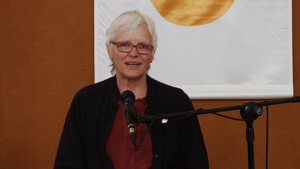
Entering the Path Online Course
Entering the Path: The Hinayana Teachings of Chögyam Trungpa, consists of nine downloadable video talks along with archive video footage, meditation instructions, contemplations, and lots more. This course is designed for you to learn at your own pace, wherever and whenever works best for you.
The Bodhisattva Path of Wisdom and Compassion Online Course
The Bodhisattva Path of Wisdom and Compassion: The Mahayana Teachings of Chögyam Trungpa presents this work for you to access at your own pace with seven downloadable video talks, meditation instructions, contemplations, and lots more.
Glimpses of Vajrayana Online Course
Glimpses of Vajrayana: The Tantric Teachings of Chögyam Trungpa consists of seven downloadable video talks along with archive video footage, meditation instructions, contemplations, and lots more.
The Hinayana path is based on training in mindfulness and awareness, cultivating virtue, and cutting grasping. While the presentation of the three yanas often gives one the sense that the “higher” yanas supersede the one before it, Trungpa Rinpoche was adamant that his students “don’t forget the Hinayana!” and presented each one as something that must be fully integrated if one wishes to truly progress on the path. Describing the Hinayana, he said, "The hinayana is called the smaller vehicle, not because it is simpleminded or lacking in vision, but because it is a pragmatic, deep-rooted approach".
His teachings on the Hinayana are very deep and practical—in no way something to skip or gloss over on the way to learning the practices of the Mahayana and Vajrayana.
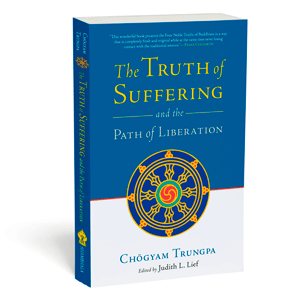
The Truth of Suffering and the Path of Liberation is Chögyam Trungpa’s in-depth exploration of the Four Noble Truths—the foundational Buddhist teaching about the origin of suffering and its cessation. It emphasizes their profound relevance not just as an inspiration when we set out on the path but at every other moment of our lives as well, showing how we can join the view—an intellectual understanding—of the teaching with practical applications in order to interrupt suffering before it arises.
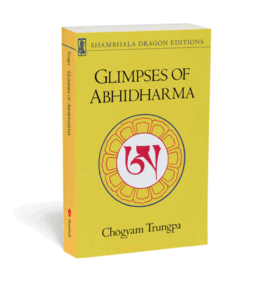
Glimpses of Abhidharma explains the Abhidharma, a collection of Buddhist scriptures that investigate the workings of the mind and the states of human consciousness. In this book, Chögyam Trungpa shows how an examination of the formation of the ego provides us with an opportunity to develop real intelligence. Trungpa also presents the practice of meditation as the means that enables us to see our psychological situation clearly and directly.
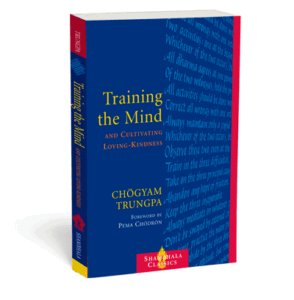
Training the Mind and Cultivating Loving-Kindness
Lojong is a particular set of practices meant to accelerate progress on the Bodhisattva path. Feel free to take a look at our Reader’s Guide on this topic to learn more. Trungpa Rinpoche’s book on this essential set of mind-training techniques is called Training the Mind and Cultivating Loving-Kindness. The fifty-nine provocative slogans have been used by Tibetan Buddhists for eight centuries to help meditation students remember and focus on important principles and practices of mind training. The slogans emphasize meeting the ordinary situations of life with intelligence and compassion under all circumstances.
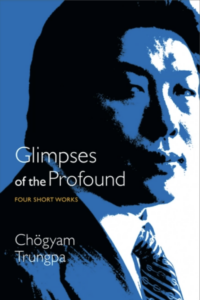
Glimpses of the Profound is a collection of four Mahayana-centric teachings on the discovery and characteristics of buddha nature, emptiness, the inseparability of the vastness of the feminine principle and the dynamism of the masculine principle, and the three bodies of enlightenment (dharmakaya, sambhogakaya, nirmanakaya).
Based on seminars with Chogyam Trungpa Rinpoche, this book was originally published as four separate volumes:
- “Glimpses of Mahayana,” on the discovery and characteristics of buddha nature
- “Glimpses of Shunyata,” on the central mahayana teaching of emptiness
- “Glimpses of Space,” on the inseparability of the vastness of the feminine principle and the dynamism of the masculine principle
- “Glimpses of Realization,” on the three bodies of enlightenment (dharmakaya, sambhogakaya, nirmanakaya)
Vajrayana, ie., Tantra, is a vast and often misunderstood subject that Trungpa Rinpoche taught on extensively. And his presentation was quite unique—really explaining it in the context of Western culture and beliefs. It is traditionally explained that it is not a system to embark on without a fully qualified teacher, both because of possible misunderstandings but—crucially—because progress cannot be made without the direct access and transmission of the lineage.
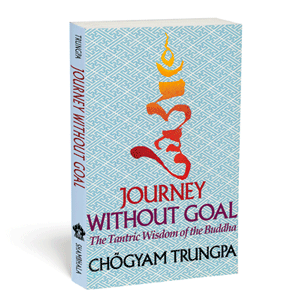
Journey without Goal: The Tantric Wisdom of the Buddha is based on the author’s talks at Naropa University. This volume introduces the reader to the principles of tantra based on the practice of meditation, leading to the discovery of egolessness. Trungpa Rinpoche provides a direct and experiential picture of the tantric world, explaining the importance of self-existing energy, the mandala principle, the role of the teacher, the meaning of tantric transmission, and the difference between Buddhist and Hindu tantra—stressing the nontheistic foundation of Buddhism. In the process, he demystifies the Vajrayana and, at the same time, affirms the power and sacredness of its ancient teaching.
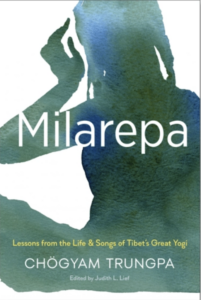
Milarepa: Lessons from the Life and Songs of Tibet’s Great Yogi: Milarepa is a central figure in Tibet, and in particular in the Kagyü tradition with Trungpa Rinpoche is so closely connected. The story of Milarepa is a tale of such extreme and powerful transformation that it might be thought not to have much direct application to our own less dramatic lives—but Chögyam Trungpa shows otherwise. This collection of his teachings on the life and songs of the great Tibetan Buddhist poet-saint reveals how Milarepa’s difficulties can be a source of guidance and inspiration for anyone. His struggles, his awakening, and the teachings from his remarkable songs provide precious wisdom for all us practitioners and show what devoted and diligent practice can achieve.
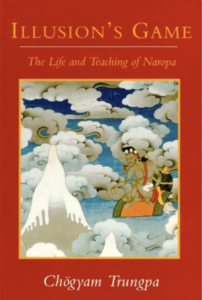
Illusion’s Game: The Life and Teaching of Naropa is a “200 percent potent” teaching according to Trungpa Rinpoche, who reveals how the spiritual path is a raw and rugged “unlearning” process that draws us away from the comfort of conventional expectations and conceptual attitudes toward a naked encounter with reality. The tantric paradigm for this process is the story of the Indian master Naropa (1016–1100), who is among the enlightened teachers of the Kagyü lineage of the Tibetan Buddhism. Naropa was the leading scholar at Nalanda, the Buddhist monastic university, when he embarked upon the lonely and arduous path to enlightenment. After a series of daunting trials, he was prepared to receive the direct transmission of the awakened state of mind from his guru, Tilopa. Teachings that he received, including those known as the six doctrines of Naropa, have been passed down in the lineages of Tibetan Buddhism for a millennium. Trungpa Rinpoche’s commentary shows the relevance of Naropa’s extraordinary journey for today’s practitioners who seek to follow the spiritual path. Naropa’s story makes it possible to delineate in very concrete terms the various levels of spiritual development that lead to the student’s readiness to meet the teacher’s mind. Trungpa Rinpoche thus opens to Western students of Buddhism the path of devotion and surrenders to the guru as the embodiment and representative of reality.
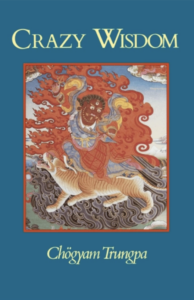
Crazy Wisdom is what Chögyam Trungpa describes “as an innocent state of mind that has the quality of early morning—fresh, sparkling, and completely awake.” This fascinating book examines the life of Padmasambhava—the revered Indian teacher who brought Buddhism to Tibet—to illustrate the principle of crazy wisdom. From this profound point of view, spiritual practice does not provide comfortable answers to pain or confusion. On the contrary, painful emotions can be appreciated as a challenging opportunity for new discovery. In particular, Trungpa Rinpoche discusses meditation as a practical way to uncover one’s own innate wisdom.
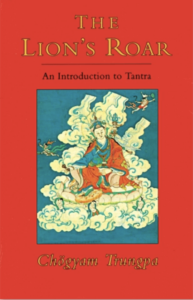
The Lion’s Roar: An Introduction to Tantra is based on two historic seminars of the 1970s in which Chögyam Trungpa introduced the tantric teachings of Tibetan Buddhism to Western students for the first time. Each seminar bore the title “The Nine Yanas.” Yana, a Sanskrit word meaning “vehicle,” refers to a body of doctrine and practical instruction that enables students to advance spiritually on the path of Buddhadharma. Nine vehicles arranged in successive levels make up the whole path of Buddhist practice. Teaching all nine means giving a total picture of the spiritual journey. Chögyam Trungpa’s nontheoretical, experiential approach opens up a world of fundamental psychological insights and subtleties. He speaks directly to a contemporary Western audience, using contemporary analogies that place the ancient teachings in the midst of ordinary life.
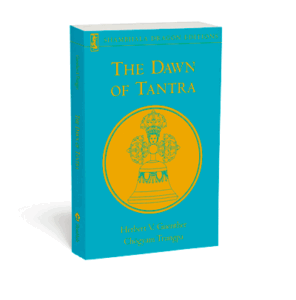
The Dawn of Tantra: A collaboration between Trungpa Rinpoche and Professor Herbert Guenther, this book was a major milestone in presenting tantra to Westerners when first published in 1975. Tibet has been shrouded in mystery, and “tantra” has been called upon to name every kind of esoteric fantasy. In The Dawn of Tantra, the reader meets a Tibetan meditation master and a Western scholar, each having a grasp of Buddhist tantra that is real and unquestionable. This collaboration is both true to the intent of the ancient Tibetan teachings and relevant to contemporary Western life.
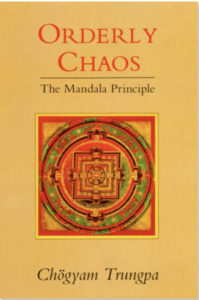
Orderly Chaos: The Mandala Principle explains how all phenomena are part of one reality. Whether good or bad, happy or sad, clear or obscure, everything is interrelated and reflects a single totality. As Chögyam Trungpa explains, from the perspective of the mandala principle, existence is orderly chaos. There is chaos and confusion because everything happens by itself, without any external ordering principle. At the same time, whatever happens expresses order and intelligence, wakeful energy and precision. Through meditative practices associated with the mandala principle, the opposites of experience—confusion and enlightenment, chaos and order, pain and pleasure—are revealed as inseparable parts of a total vision of reality.
The Mandala Principle Online Course
We also offer an excellent online course elaborating on this topic called The Mandala Principletaught by Judy Lief, available on-demand. It includes six downloadable video talks along with additional videos of meditation instruction, contemplations, assessment questions, and more.
Glimpses of Mahamudra Online Course
Glimpses of Mahamudra: An Online Course : Mahamudra is a meditation tradition within tantric Buddhism that points to the nature of awareness itself, elevating our ordinary perception to the level of the sacred. In this view, all experiences arise from a mind that is naturally vast, empty, and luminous. In this online course, esteemed Buddhist teacher and editor Judith Lief takes us on a journey through the mahamudra teachings of Chögyam Trungpa Rinpoche as presented in his Profound Treasury of the Ocean of Dharma.
Inspired by Zen
Trungpa Rinpoche had a particular connection to Japanese culture generally and Zen specifically. He introduced many rituals and ceremonies from Japan to his students including ikebana, oroyoki, the tea ceremony, and more. In The Teacup and the Skullcup: Where Zen and Tantra Meet, Rinpoche presents the strength and discipline gained from Zen. Through these talks you can see his respect for the Zen tradition and how it led to his using certain Zen forms for his public meditation hall rituals. He discusses the differences in style, feeling, and emphasis that distinguish the two paths and shows what each one might learn from the other. Also included are Trungpa Rinpoche’s commentary on the Ten Oxherding Pictures and an essay he composed in memory of Shunryu Suzuki Roshi, a close friend with whom he continually exchanged ideas for furthering buddhadharma in America.
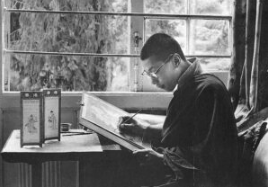
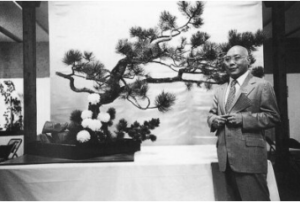
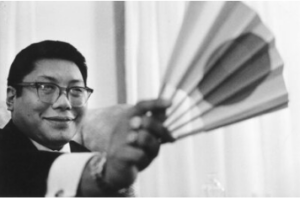
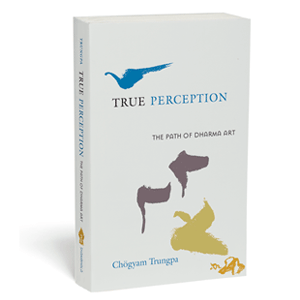
True Perception: The Path of Dharma Art starts with the premise that art has the power to awaken and liberate. Trungpa Rinpoche called this type of art “dharma art”—any creative work that springs from an awakened state of mind, characterized by directness, unselfconsciousness, and nonaggression. Dharma art provides a vehicle to appreciate the nature of things as they are and express it without any struggle or desire to achieve. A work of dharma art brings out the goodness and dignity of the situation it reflects—dignity that comes from the artist’s interest in the details of life and sense of appreciation for experience. He shows how the principles of dharma art extend to everyday life: any activity can provide an opportunity to relax and open our senses to the phenomenal world.
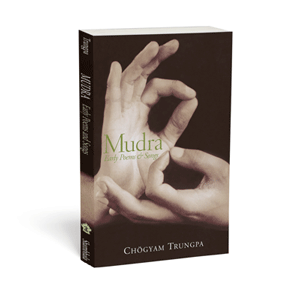
Mudra: Early Poems and Songs: A mudra is a symbolic gesture or action that gives physical expression to an inner state. This book of poetry and songs of devotion, written by Chögyam Trungpa between 1959 and 1971, is spontaneous and celebratory. This volume also includes the ten traditional Zen oxherding pictures accompanied by a unique commentary that offers an unmistakably Tibetan flavor. Fans of this renowned teacher will enjoy the heartfelt devotional quality of this early work.
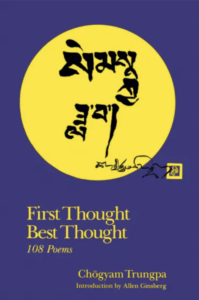
First Thought Best Thought: 108 Poems contains both poems and songs—most of which were written since Chögyam Trungpa’s arrival in the United States in 1970—that combine a background in classical Tibetan poetry with Rinpoche’s intuitive insight into the spirit of America, a spirit that is powerfully evoked in his use of colloquial metaphors and contemporary imagery. Most of the poems were originally written in English—clearly the result of his own perceptions of new forms and media offered to him by a different culture. Each poem has its own insight and power, which come from a skillful blend of traditional Asian subtlety and precision combined with a thoroughly modern vernacular. Several of Chögyam Trungpa’s calligraphies also accompany the collection. Edited by Trungpa Rinpoche's private secretary and author David Rome.
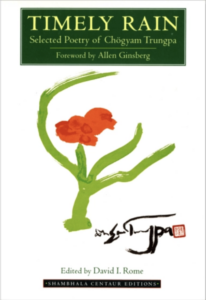
Newly selected poetry from previously published and unpublished works, Timely Rain: Selected Poetry of Chogyam Trungpa is the definitive edition of poems and sacred songs of the renowned Tibetan meditation master. It contains some poems from the works above as well as other sources. Edited by Trungpa Rinpoche's private secretary and author David Rome.
As explained above, the Shambhala teachings, a complement to the Buddhist teachings, are a set of secular instructions which give the reader an idea of what an enlightened society could be. It introduces meditation from the point of view of basic human goodness and bravery.
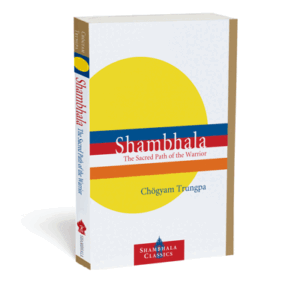
Shambhala: The Sacred Path of the Warrior is the foundation of the Shambhala teachings. To begin, there is a basic human wisdom that can help solve the world’s problems. It doesn’t belong to any one culture or region or religious tradition—though it can be found in many of them throughout history. It’s what Chögyam Trungpa called the sacred path of the warrior. The sacred warrior conquers the world not through violence or aggression but through gentleness, courage, and self-knowledge. The warrior discovers the basic goodness of human life and radiates that goodness out into the world for the peace and sanity of others. That’s what the Shambhala teachings are all about, and this is the book that has been presenting them to a wide and appreciative audience for more than thirty years.
Audiobook
Ready by Carolyn Rose Gimian
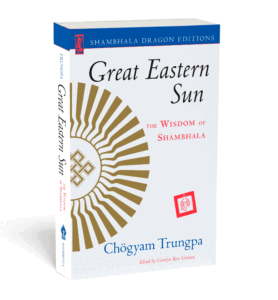
Great Eastern Sun: The Wisdom of Shambhala is a continuation of what is presented in Shambhala: The Sacred Path. While Shambhala was an exploration of human goodness and its potential to create an enlightened society—a state that the author calls “nowness,” Great Eastern Sun—which is accessible to meditators and nonmeditators alike—centers on the question, “Since we’re here, how are we going to live from now on?” The main themes are trust, renunciation and letting go, reiterated in many different forms, with an emphasis on how the Shambhala warrior works with these aspects of their path, in order to help others.
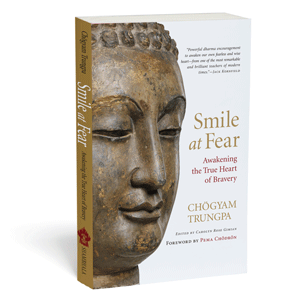
In Smile at Fear: Awakening the True Heart of Bravery, Chögyam Trungpa offers the insights and strategies to make friends with and tame fear. Many of us, without even realizing it, are dominated by fear. We might be aware of some of our fears—perhaps we are afraid of public speaking, of financial hardship, or of losing a loved one. Chögyam Trungpa shows that most of us suffer from a far more pervasive fearfulness: fear of ourselves. We feel ashamed and embarrassed to look at our feelings or acknowledge our styles of thinking and acting; we might turn away from the reality of our moment-to-moment experience. It is this fear that keeps us trapped in cycles of suffering, despair, and distress. Chögyam Trungpa offers us a vision of moving beyond fear to discover the innate bravery, trust, and delight in life that lies at the core of our being. Drawing on the Shambhala teachings, he explains how we can each become a spiritual warrior: a person who faces each moment of life with openness and fearlessness. Afer all, “The ultimate definition of bravery is not being afraid of who you are,” writes Chögyam Trungpa. In Smile at Fear, he also looks at how to work with real obstacles in life, not just our psychological state of mind.
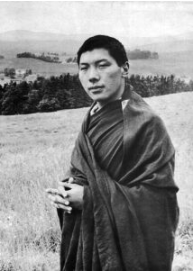
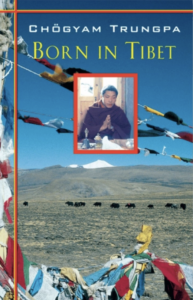
Born in Tibet is Trungpa Rinpoche’s own account of his life up through coming to the West. As the eleventh in the teaching lineage known as the Trungpa tulkus, he underwent a period of intensive training in meditation, philosophy, and fine arts, receiving full ordination as a monk in 1958 at the age of eighteen. The following year, the Chinese Communists invaded Tibet, and the young Chögyam Trungpa spent many harrowing months trekking over the Himalayas, narrowly escaping capture.Trungpa Rinpoche’s account of his experiences as a young monk, his duties as the abbot and spiritual head of a great monastery, and his moving relationships with his teachers offers a rare and intimate glimpse into the life of a Tibetan lama. The memoir concludes with his daring escape from Tibet to India. In an epilogue, he describes his emigration to the West, where he encountered many people eager to learn about the ancient wisdom of Tibetan Buddhism.
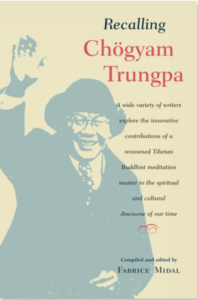
Recalling Chögyam Trungpa contains a wide-range of essays and interviews from contributors in the fields of Buddhist practice and scholarship, philosophy, the arts, and literature examining the work of Trungpa Rinpoche. Rinpoche had a distinct knack for breaking down the cultural, historical, and ideological barriers that made the transmission so difficult. His skill at communicating in a living language to Western students, while remaining faithful to the traditional origins of Buddhism, was paired with an understanding of the modern world with unusual relevance. As a result, his activities in a wide range of areas—including psychology, education, theater, poetry, visual arts, translation, publishing, interreligious dialogue, the creation of a path of spiritual warriorship, and the founding of the first Buddhist university in North America—offer penetrating insights into the meaning of Buddhism for our world and our culture. This anthology is a testimony to the continuing influence of his unique qualities and work as a revitalizing force in spheres both spiritual and secular.
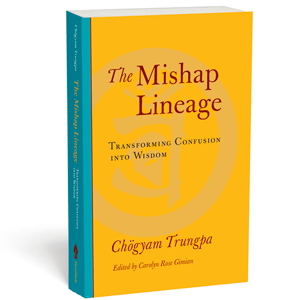
The Mishap Lineage: Transforming Confusion into Wisdom is not specifically biographical, but still illustrates the transformative principle of using obstacles and challenges as fuel for the spiritual path through telling the lively history of the Trungpa tulkus (a lineage within the Kagyü tradition of Tibetan Buddhism) of which he was the eleventh incarnation. Trungpa Rinpoche referred to his lineage as the “Mishap Lineage” because of the ups and downs and colorful lives that were typical of his predecessors—and true of his own life as well. The stories of the Trungpas are seen as a guide for the practitioner’s journey and help us to understand how important lineage and community remain for us today.
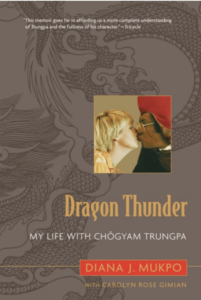
Dragon Thunder: My Life with Chögyam Trungpa is Diana Mukpo’s account of her life with Rinpoche. Diana, Rinpoche's wife, led an extraordinary and unusual life as the “first lady” of a burgeoning Buddhist community in the American 1970s and ’80s. She gave birth to four sons, three of whom were recognized as reincarnations of high Tibetan lamas. It is not a simple matter to be a modern Western woman married to a Tibetan Buddhist master, let alone to a public figure who is sought out and adored by thousands of eager students. Surprising events and colorful people fill the narrative as Diana seeks to understand the dynamic, puzzling, and larger-than-life man she married—and to find a place for herself in his unusual world.Rich in ambiguity, Dragon Thunder is the story of an uncommon marriage and also a stirring evocation of the poignancy of life and relationships—from a woman who has lived boldly and with originality.
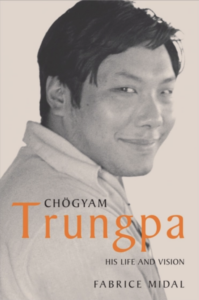
Chögyam Trungpa: His Life and Vision by Fabrice Midal is a comprehensive and gripping account of the many dimensions of Chögyam Trungpa’s life and legacy. Covering a broad range of his activities and including a full history of his life and teachings, it is a superb account revealing a clear view of Rinpoche’s legacy.
Buddhists are experts on death and dying—reflecting on it is entwined with every moment of a practitioner’s reflections. The Tibetan tradition has a highly evolved body of teachings on death and the dying process—and how it relates to life here and now. Two of Trungpa Rinpoche’s books are devoted to the two sides of this coin.
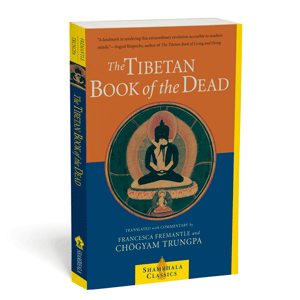
The Tibetan Book of the Dead: The Great Liberation through Hearing in the Bardo
In this classic scripture of Tibetan Buddhism—traditionally read aloud to the dying to help them attain liberation—death and rebirth are seen as a process that provides an opportunity to recognize the true nature of mind. This translation of The Tibetan Book of the Dead emphasizes the practical advice that the book offers to the living. The insightful commentary by Chögyam Trungpa, written in clear, concise language, explains what the text teaches us about human psychology. This book will be of interest to people concerned with death and dying, as well as those who seek greater spiritual understanding in everyday life.
Audiobook
Ready by Richard Gere
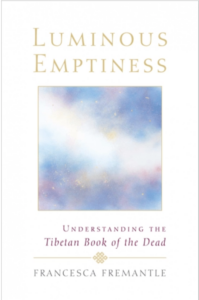
Luminous Emptiness: Understanding the Tibetan Book of the Dead
According to the Buddhist view, nothing is permanent or fixed. The entire world of our experience is constantly appearing and disappearing at every moment. Using vivid and dramatic imagery, the Tibetan Book of the Dead presents the notion that most of us are living in a dream that will continue from lifetime to lifetime until we truly awaken by becoming enlightened. Here, Fremantle, who worked closely with Chögyam Trungpa on the 1975 translation of the Tibetan Book of the Dead (Shambhala), brings the expertise of a lifetime of study to rendering this intriguing classic more accessible and meaningful to the living.
To date, there are ten volumes of Trungpa Rinpoche’s Collected Works, and all of them contain material not previously published in book form.
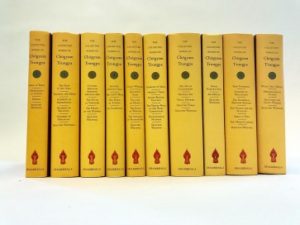
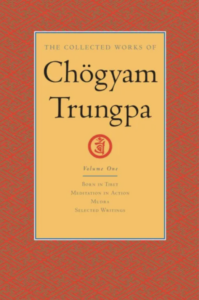
Volume One contains Trungpa Rinpoche’s early writings in Great Britain, including Born in Tibet (1966); Meditation in Action (1969), and Mudra (1972). Among the selected articles from the 1960s and ’70s are early teachings on compassion and the Bodhisattva path. Other articles contain unique information on the history of Buddhism in Tibet; an exposition of teachings of Dzogchen with the earliest meditation instruction by Trungpa Rinpoche ever to appear in print; and an intriguing discussion of society and politics, which may be the first recorded germ of the Shambhala teachings.
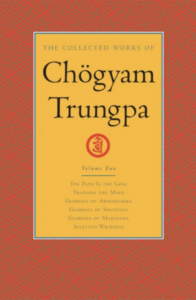
Volume Two examines meditation, mind, and Mahayana, the “great vehicle” for the development of compassion and the means to help others. Chögyam Trungpa introduced a new psychological language and way of looking at the Buddhist teachings in the West. His teachings on human psychology and the human mind are included in this volume. It includes The Path Is the Goal; Training the Mind; Glimpses of Abhidharma; Glimpses of Shunyata; Glimpses of Mahayana; and other selected writing.
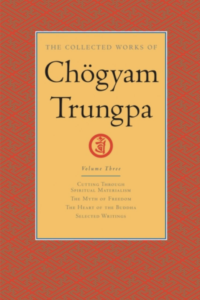
Volume Three captures the distinctive voice that Chögyam Trungpa developed in North America in the 1970s and reflects the preoccupations among Western students of that era. It includes Cutting Through Spiritual Materialism and The Myth of Freedom, the two books that put Chögyam Trungpa on the map of the American spiritual scene. The Heart of the Buddha and sixteen articles and forewords complete this volume.
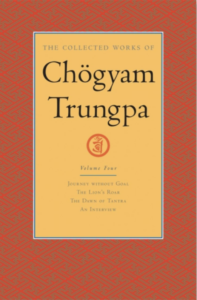
Volume Four presents introductory writings on the Vajrayana tantric teachings, clearing up Western misconceptions about Buddhist tantra. It includes three full-length books and a 1976 interview in which Chögyam Trungpa offers penetrating comments on the challenge of bringing the Vajrayana teachings to America. It includes Journey without Goal; The Lion’s Roar; The Dawn of Tantra; and an interview with Chögyam Trungpa.
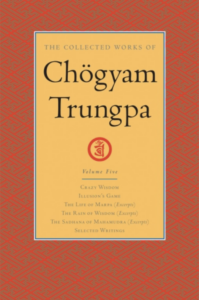
Volume Five focuses on the lineages of great teachers who have transmitted the Tibetan Buddhist teachings and on the practice of devotion to the spiritual teacher. It includes inspirational commentaries by Chögyam Trungpa on the lives of famous masters such as Padmasambhava, Naropa, Milarepa, Marpa, and Tilopa, as well as an excerpt from The Sadhana of Mahamudra, a tantric text that Chögyam Trungpa received as terma in 1968. It includes Crazy Wisdom and Illusion’s Game, as well as excerpts from The Life of Marpa, The Rain of Wisdom and The Sadhana of Mahamudra. The selected writings also include “Explanation of the Vajra Guru Mantra,” an article never before published, which deals with the mantra that invokes Guru Rinpoche; seminar talks available in book form for the first time; and previously unpublished articles on Milarepa.
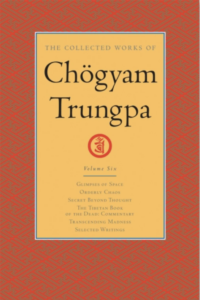
Volume Six contains advanced teachings on the nature of mind and tantric experiences. Chögyam Trungpa’s commentary on The Tibetan Book of the Dead explains what this classic text teaches about human psychology. Transcending Madness presents a unique view of the Tibetan concept of bardo. Orderly Chaos explains the inner meaning of the mandala. Secret Beyond Thought presents teachings on the five chakras and the four karmas. Glimpses of Space consists of two seminars: “The Feminine Principle” and “Evam.” In the article “Femininity,” Chögyam Trungpa presents a playful look at the role of feminine energy in Buddhist teachings. And “The Bardo,” based on teachings given in England in the 1960s, had not been available in published form for many years.
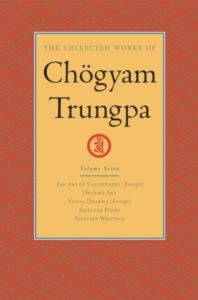
Volume Seven features the work of Chögyam Trungpa as a poet, playwright, and visual artist and his teachings on art and the creative process, which are among the most innovative and provocative aspects of his activities in the West. While it includes material in which Trungpa Rinpoche shares his knowledge of the symbolism and iconography of traditional Buddhist arts (in Visual Dharma), this richly varied volume primarily focuses on his own, often radical creative expressions. The Art of Calligraphy is a wonderful showcase for his calligraphy, and Dharma Art brings together his ideas on art, the artistic process, and aesthetics. Tibetan poetics, filmmaking, theater, and art and education are among the topics of the selected writings. All of CTR’s published poetry is included in this volume, including many poems published in small journals and never before compiled into a book.
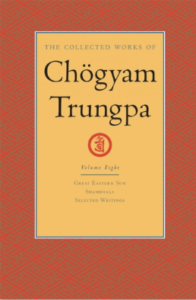
Volume Eight covers matters of culture, state, and society. The two complete books reprinted here—Shambhala: The Sacred Path of the Warrior and Great Eastern Sun: The Wisdom of Shambhala—explore the vision of an ancient legendary kingdom in Central Asia that is viewed as a model for enlightened society and as the ground of wakefulness and sanity that exists as a potential within every human being. The selected writings include discussions of political consciousness, the martial arts, and the true meaning of warriorship. Two of the many previously unpublished articles are “The Martial Arts and the Art of War,” on the place of warriorship in the Buddhist teachings, and “The Seven Treasures of the Universal Monarch,” a little gem describing the world of the Shambhala monarch.
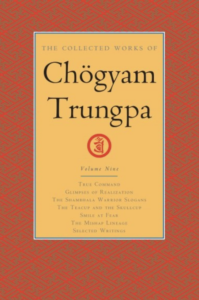
Volume Nine contains an extremely diverse group of teachings from True Command; Glimpses of Realization; the Shambhala Warrior Slogans; The Teacup and the Skullcup; Smile at Fear; The Mishap Lineage; and other selected writings. This collection includes both early and later talks—from an article published in 1966 in India to books published in the new millennium to material from a set of cards that present the Shambhala warrior slogans. The subject matter ranges from Zen to dharma art, from Shambhala politics to Vajrayana buddhadharma. The selected writings in this book are articles from before Chögyam Trungpa’s death in 1987 and include two interviews and several previously unpublished pieces.
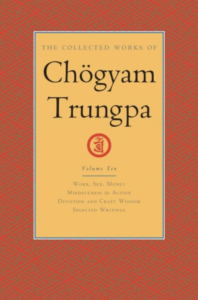
Volume Ten begins with Chögyam Trungpa’s three most recent books: Work, Sex, Money; Mindfulness in Action; and Devotion and Crazy Wisdom (published by Kalapa Media). The first two books in the volume emphasize the importance of meditation in action and bringing awareness, mindfulness, intentionality, and a sense of the sacred into everyday life. The third book explores devotion and discusses mutual commitment and surrendering between teacher and student. The selected writings in this volume range from older articles originally published in the Vajradhatu Sun to recently edited articles, including several that have not yet appeared in print. Overall, these articles show us how Trungpa Rinpoche worked deeply and directly with many interest groups and subsections of the community, and how he infused each situation with dharma, taking every opportunity to present essential teachings.
The editors he trained are now training a new generation of editors to work on the vast amount of material ready to be mined for publication. Stay tuned!

